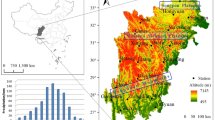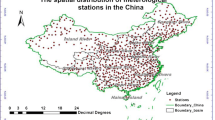Abstract
Extreme precipitation event is rare and mostly occurs on a relatively small local scale, which presents marked uncertainties when analyzing its characteristics. Using daily precipitation data covering 1959–2009 from 62 stations over the Pearl River Basin, the percentile method (PM) and the absolute critical value method (ACVM) are applied to define extreme precipitation thresholds (EPT), and their different impacts on the spatial–temporal distribution of extreme precipitation event were analyzed in this study. The findings of this study show: (1) Using the K-means clustering algorithm in terms of precipitation indices and the topography, longitude and latitude of each station, the whole basin is divided into eight precipitation zones. (2) The extreme indices, including extreme precipitation frequency, extreme precipitation proportion and proportion of extremely n-day precipitation, calculated by PM are markedly higher than those calculated by ACVM during five decades, which is particularly obvious in the low precipitation area such as the west-northern of the basin since more daily precipitation events are treated as extreme precipitation in this region if EPT is defined by PM. (3) The spatial distributions of extreme frequencies respectively calculated by these two methods are quite different across the basin. The spatial distribution of extreme frequencies calculated by ACVM shows a high-value center in the southeast coastal areas and a low-value center in the northwest mountain areas. However, the extreme frequencies calculated by PM distribute evenly over the basin, which is obviously inconsistent with the empirical results, an area with heavy precipitation usually has a high extreme precipitation frequency, and vice versa.









Similar content being viewed by others
References
Anagnostopoulou C, Tolika K (2012) Extreme precipitation in Europe: statistical threshold selection based on climatological criteria. Theoret Appl Climatol 1073:479–489
Asong ZE, Khaliq MN, Wheater HS (2015) Regionalization of precipitation characteristics in the Canadian Prairie Provinces using large-scale atmospheric covariates and geophysical attributes. Stoch Environ Res Risk Assess 293:875–892
Begueria S (2004) Uncertainties in partial duration series modelling of extremes related to the choice of the threshold value. J Hydrol 3031:215–230
Bell JL, Sloan LC, Snyder MA (2004) Regional changes in extreme climatic events: a future climate scenario. J Clim 171:81–87
Chen Y, Chen XY, Ren GY (2011) Variation of extreme precipitation over large river basins in China. Adv Clim Change Res 22:108–114
Chi XX, Yin ZE, Wang X, Sun YK (2015) Spatiotemporal variations of precipitation extremes of China during the past 50 years (1960–2009). Theoret Appl Climatol 124:1–10
Easterling DR, Evans JL (2000) Observed variability and trends in extreme climate events: a brief review. Bull Am Meteor Soc. 813:417–426
Hartmann H, Buchanan H (2014) Trends in extreme precipitation events in the Indus River Basin and flooding in Pakistan. Atmos Ocean 521:77–91
Hosking JRM, Wallis JR (1997) Mathematical geology. Cambridge University Press, Cambridge, pp 535–537
Irvine KN, Waylen PR (1986) Partial series analysis of high flows in Canadian rivers. Can Water Resour J 112:83–91
Jiang ZH, Ding YG, Zhu LF, Zhang JL, Zhu LH (2009) Extreme precipitation experimentation over eastern China based on Generalized Pareto Distribution. Plateau Meteorol. 283:573–580 (in Chinese)
Kaufman L, Rousseeuw P (1990) Finding groups in data: an introduction to cluster analysis. Wiley Press, New York
Kozaric T, Picek BI (2006) Meteorological features of extreme precipitation in the Northern Adriatic. Croatian Meteorol J 4141:53–67
Lang M, Ouarde TBMJ, Bobee B (1999) Towards operational guidelines for over-threshold modeling. J Hydrol 225:103–117
Li ZL, Li CC, Xu ZX, Zhou X (2014) Frequency analysis of precipitation extremes in Heihe River basin based on generalized Pareto distribution. Stoch Environ Res Risk Assess 287:1709–1721
Liu BJ, Chen JF, Chen XH, Lian YQ, Wu LL (2013a) Uncertainty in determining extreme precipitation thresholds. J Hydrol 503:233–245
Liu BJ, Chen XH, Lian YQ, Wu LL (2013b) Entropy-based assessment and zoning of rainfall distribution. J Hydrol 490:32–40
MacQueen J (1967) Proceedings of 5th Berkeley symposium on mathematical statistics and probability, vol 1. University of California Press, Berkeley, pp 281–297
Magana V, Perez J, Mendez M (2003) Diagnosis and prognosis of extreme precipitation events in the Mexico City Basin. Geofis Int Mexico 42(2):247–260
Min S, Qian YF (2008) Regionality and persistence of extreme precipitation events in China. Adv Water Sci 06:763–771 (in Chinese)
Mitchell J M, Dzerdzeevskii B, et al. (1966) Climate change, WMO Technical Note No. 79, World Meteorological Organization 79
Plummer N, Salinger MJ, Nicholls N, et al. (1999) Changes in climate extremes over the Australian region and New Zealand during the twentieth century. In: Kattenberg A, Maskell K (eds) Weather and climate extremes. Springer, Dortrecht, pp 183–202
Qian W, Lin X (2005) Regional trends in recent precipitation indices in China. Meteorol Atmos Phys 90(3–4):193–207
Rodrigo FS (2010) Changes in the probability of extreme daily precipitation observed from 1951 to 2002 in the Iberian Peninsula. Int J Climatol 3010:1512–1525
Roth M, Buishand TA, Jongbloed G, Klein Tank AMG, van Zanten JH (2014) Projections of precipitation extremes based on a regional, non-stationary peaks-over-threshold approach: a case study for the Netherlands and north-western Germany. Weather Clim Extremes 4:1–10
Roy SS, Balling RC (2004) Trends in extreme daily precipitation indices in India. Int J Climatol 244:457–466
Saf B (2010) Assessment of the effects of discordant sites on regional flood frequency analysis. J Hydrol 380(3):362–375
Si B, Yu JH, Ding YG (2012) Research on extreme value distribution of short-duration heavy precipitation in the Sichuan Basin. J Meteorol Sci 324:403–410 (in Chinese)
Sonmez I, Komuscu AU (2011) Reclassification of rainfall regions of Turkey by K-means methodology and their temporal variability in relation to North Atlantic Oscillation (NAO). Oretical Appl Climatol 1063–4:499–510
Sun HL (2000) China encyclopedia of resources science. China University of Petroleum Press, Beijing
Tzavelas G, Paliatsos AG, Nastos PT (2010) Brief communication “Models for the exceedances of high thresholds over the precipitation daily totals in Athens, Greece”. Nat Hazards Earth Syst Sci 101:105–108
Wan L, Zhang XP, Ma Q, Zhang JJ, Ma TY, Sun YP (2014) Spatiotemporal characteristics of precipitation and extreme events on the Loess Plateau of China between 1957 and 2009. Hydrol Process 2818:4971–4983
Wang YQ, Zhou L (2005) Observed trends in extreme precipitation events in China during 1961–2001 and the associated changes in large-scale circulation. Geophys Res Lett 32:L09707
Wang WG, Shao QX, Peng SZ, Zhang ZX, Xing WQ, An GY, Yong B (2011) Spatial and temporal patterns of changes in precipitation during 1957–2007 in the Haihe River basin, China. Stoch Environ Res Risk Assess 25(7):881–895
Waylen PR, Woo MK (1983) Stochastic analysis of high flows in some central British Columbia rivers. Can J Civil Eng 102:639–648
Yang T, Shao QX, Hao ZC, Chen X, Zhang ZX, Xu CY, Sun LM (2010) Regional frequency analysis and spatio-temporal pattern characterization of rainfall extremes in the Pearl River Basin, China. J Hydrol 380(3–4):386–405
Zhai PM, Zhang XB, Wang H, Pan XH (2005) Trends in total precipitation and frequency of daily precipitation extremes over China. J Clim 18(7):1096–1108
Zhang Q, Cong ZT (2013) Trends of precipitation intensity and frequency in hydrological regions of China from 1956 to 2005. Glob Planet Change 117:40–51
Zhang Q, Singh VP, Peng JT (2012) Spatial–temporal changes of precipitation structure across the Pearl River basin, China. J Hydrol 440–441:113–122
Zhang Q, Zhang JQ, Yan DH, Wang YF (2014) Extreme precipitation events identified using detrended fluctuation analysis (DFA) in Anhui, China. Theor Appl Climatol 117:169–174
Acknowledgments
The research in this paper is fully supported by the National Natural Science Foundation of China (Grant No. 91547108, and 41301627), and the Water Conservancy Science and Technology Project of Guangdong Province, China (Grant No. 2014-20). We would like to thank the National Climatic Centre (NCC) of the China Meteorological Administration (CMA) for providing the valuable meteorological data and Enago (www.enago.cn) for the English language review.
Author information
Authors and Affiliations
Corresponding author
Rights and permissions
About this article
Cite this article
Liu, B., Chen, X., Chen, J. et al. Impacts of different threshold definition methods on analyzing temporal-spatial features of extreme precipitation in the Pearl River Basin. Stoch Environ Res Risk Assess 31, 1241–1252 (2017). https://doi.org/10.1007/s00477-016-1284-9
Published:
Issue Date:
DOI: https://doi.org/10.1007/s00477-016-1284-9




